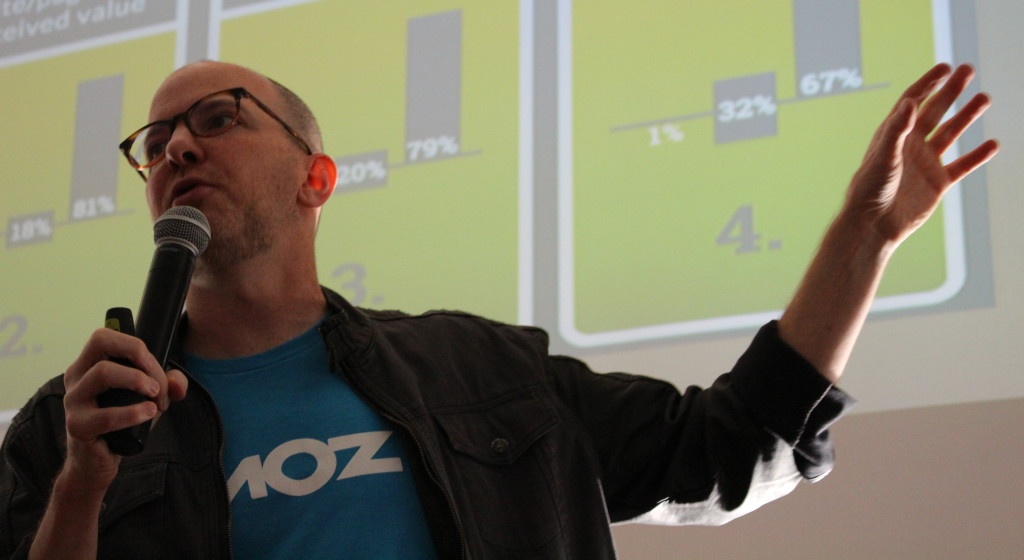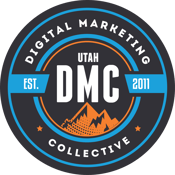 We kicked off the day with Cyrus Shepard, Director of Audience Development at Moz. His presentation reminded us all that SEO should always be focused on the end result for our users, not the end result for search engines. Moz has had a pretty good run the last few years. 600% growth in 5 years. This is not that great, anyone can achieve this. When you say you work at Moz, people think you know things that you don’t know. This is the myth of advanced SEO—that there are tricks out there that will do things that regular SEO can't.
We kicked off the day with Cyrus Shepard, Director of Audience Development at Moz. His presentation reminded us all that SEO should always be focused on the end result for our users, not the end result for search engines. Moz has had a pretty good run the last few years. 600% growth in 5 years. This is not that great, anyone can achieve this. When you say you work at Moz, people think you know things that you don’t know. This is the myth of advanced SEO—that there are tricks out there that will do things that regular SEO can't.
The New Paradigm: The Rise of User Inputs
This is the revolution that’s taking place within search engines for a long time, but we haven’t been paying attention. We do SEO to our sites all the time, but we forget to ask ourselves what the user wants. We have to ask ourselves, is this what the user really wants? Google has been telling us to optimize for users, not search engines for years. We have been ignoring this, thinking that the user stuff is just fluffy. In reality, user inputs are now a ranking signal. They are the future of SEO. Analysis of perceived value, quantity/quality of instant answers provided in SERPs, and usage data all deal with how the user is actually interacting with the page. Traditional SEO features like domain authority and URL will either stay the same or decrease. You still need to pay attention to them, but they are less important. We know how to measure these traditional techniques, but these user elements are harder to measure. To help us understand how to shift our focus towards our users, Cyrus shared the following tips for how to optimize for your users.
The user chooses you
One of the very things google looks at is the click-through rate. Is the user choosing you? Which result is the user picking? It’s controversial, Google uses it sometimes, sometimes say they don’t. But the question is, does Google use this as a ranking symbol? Cyrus' answer is that it doesn't really matter. Optimize towards user intent, not what you think you should optimize for. When you've done all the work to get the user to click on you, realize that your work is in no way done.
Optimize for task completion
Once you get people to click you, it’s not over. Your information needs to be what the user is actually looking for. People want to complete a task when they get to your page, and your site should get them there. Optimize your website to help people complete their task, not just to click on your site. User opportunities to help people complete what they want to do. Users will be much more satisfied with your website if you find a way to help them with what they're looking for, even if that wasn't your original intent.
Answer questions humans haven’t asked yet
Answer the questions the robots told us about (that you’re trying to rank for), but also try to answer the questions you think humans may also be looking for. One page can have many answers. When you answer as many questions as you can that users haven’t asked yet, you rank for the long-tail keywords you can’t predict. Successful sites are those that encourage you to browse, not just answer the one question you came for.
Provide supplemental content
No one talks about supplemental content. Google talks about supplemental content all the time, but Google doesn’t advertise that they’re talking about it. Google ranks hundreds of contractors to judge the quality of results and rate the quality of the results. One of the rankings these people rate the page on is helpful supplemental content. It’s “what makes a high quality page a great experience.” YouTube is almost all supplemental content (suggested videos, comments, etc.). Supplemental content makes your page a rich experience. It can take the form of related articles, links, naviagation aids, tools, resources—the sky is the limit. Try to hone it in and look at what users are looking for. Look for things that make the experience extra meaningful to them
Format for humans
We know how to format for humans, not for robots. Cyrus even admitted, "I'm kind of embarrassed that we still need to talk about this in 2015." The team at Moz spent about ten minutes per page adding rich formatting, and because of these efforts, their average time on page increased 63% and their bounce rate improved by over 20%. This is an easy fix with a big reward.
Build links through people
Moz invests almost 3 times as much in social media than we do in content marketing and SEO. Cyrus said, "It's what we want to engage with our readers." People lead to links in the end. Cyrus also suggested to hire awesome PR people, as they "often do better SEO than SEOs themselves.
Try it for yourself
Cyrus left the audience with the following homework:
- Choose a series of low-to-mid performing pages.
- Use keyword data to discover mismatches between intent and optimization
- Optimize for user intent, i.e. title, description, on-page copy, etc. Optimize for people, not for SEO. Try to capture that in your copy and your call to action.
- Improve task completion.
- Submit for re-indexing
- Tweak and repeat as necessary
Cyrus summed his presentation up well with the following: “I’m doing some of the best SEO I’ve done in my life and it feels good because I’m helping the user find what they want, when they want it.” Many thanks to Cyrus for reminding us to always prioritize the user. A huge thanks to Cyrus for joining us at DMC 2015.
